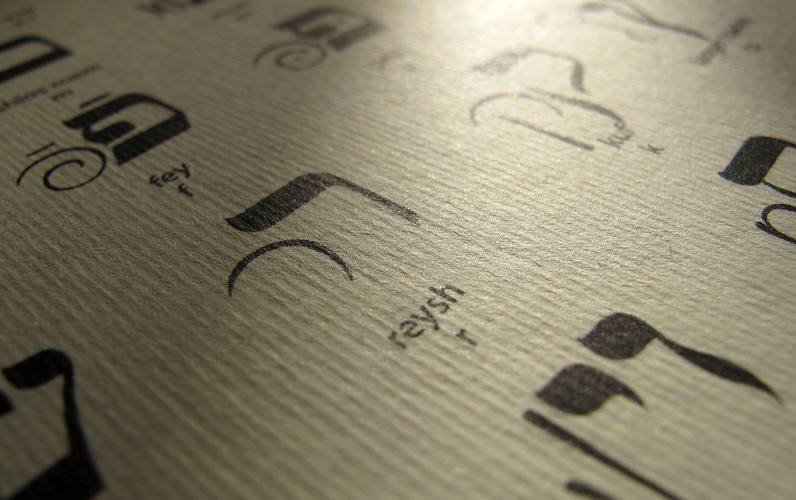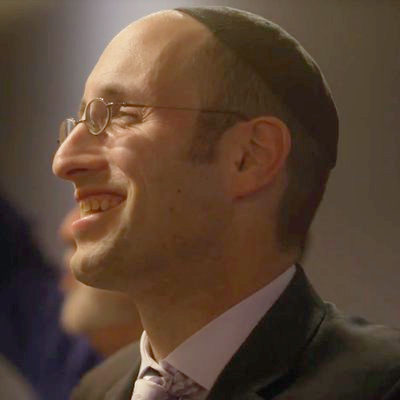Yiddish is a Language of Faith
No matter how hard some try to disconnect it, Yiddish is inseparable from the world of observant Judaism.

Early in 2021, a niche online argument made its way onto the front page of the Wall Street Journal, complete with a catchy headline: “Designing a Flag for Yiddish Takes Chutzpah.” The cause of the disagreement was the announcement by Duolingo, a website for learning languages, that it would release a course for Yiddish. Usually, the symbol for a language would be the flag of its home country: France, Italy, Japan. Yiddish, however, was a language of exile; the Israeli flag would represent Hebrew, not Yiddish. What, then, should serve as its symbol? Suggestions abounded, including that the website should “just put a bagel on it,” or that it should feature a “fiddler on a roof.”
The contretemps is intriguing because it inspires the inquiry: What makes Yiddish unique? If every language has its individual character, what exactly characterizes Yiddish? Jews give many answers to this, but not all are equally correct. The Journal reports that one suggestion for the Duolingo symbol was the word “kvetch” surrounded by a circle; this reflected the thesis put forward by Michael Wex in his bestselling Born to Kvetch, which argues that Yiddish provides a way of “seeing the world in cataract-colored glasses.” But does “kvetch” truly capture Yiddish? It is true, of course, that Yiddish is a magnificent language for anyone who wants to say something unkind. As Leo Rosten noted, “little miracles of discriminatory precision” exist in the difference between a nebekh, a shlep, a shmendrik, a shlump, a klutz, a yold, a shnook, a Chaim Yankel, a bulbenik, a shoyteh, a shlemazel, and a shlemiel; all of these terms describe pathetic people, but there are different reasons as to why they are pathetic.
Yet to reduce Yiddish in this way is to commit a calumny against a language that is not about negativity. Isaac Bashevis Singer was surely correct when, in his Nobel Prize address, he argued that there is in Yiddish “a gratitude for every day of life, every crumb of success, each encounter of love.” The most insightful summation of Yiddish’s character was put forward by Max Weinreich, the 20th century’s greatest scholar of the language, who argued that Yiddish embodies the Derekh HaShaS, or “the way of the Talmud.” By this he meant not that the Talmud was written by Yiddish speakers, but that Yiddish trains its speakers to see the entire world from a Talmudic perspective, so that every aspect of reality is described in similes and metaphors that refer back, in some profound way, to the life of halakhic Judaism. Wex more accurately captures Yiddish’s essential nature when he focuses not on kvetching but on the fact that “the Talmud is nothing less than Yiddish in utero. The Jews who initiated the transmutation of German into Yiddish were those Jews most deeply connected to Jewish law, people for whom the categories and mental processes of halokhe, of Jewish law, were practically second nature.”
A plethora of idioms in Yiddish reflect this, and Weinreich notes many of them. If one wishes to express that something happens often, one says that it occurs Yeder montig un donershtig, every Monday and Thursday, because the weekday Torah readings take place on them. In contrast, something that occurs rarely happens every “year and a Wednesday,” reflecting the tradition of the Talmudic age that a wedding would take place a year after a betrothal, and that Wednesday was considered the best day for the ritual to occur. Since every married male Jew among the Ashkenazim wore a tallis, a prayer shawl, a statement in Yiddish that “our town has thirty talleisim” means that there are thirty families.
Most Jews, of course, were not learned in the Talmud; their everyday experience of rabbinic Judaism came from the liturgy of its rabbis. Thus the siddur, the prayer book, became a primary source of similes. If one wishes to express that he is fully conversant in something, he might say klor vi a yid in Ashrei—“clear as a Jew saying Ashrei,” the central psalm of the morning prayer, because that was one everyone knew by heart. One who is at the end of an endeavor is called arriving tsu aleinu, in reference to Aleinu, the last liturgical passage of the daily service. A “yes man” is called an amein zoger, one who says “amen,” the standard refrain in a service, and to express deep regret, one might say shlogn zikh al khet, which is a reference to the beating of the chest that occurs during penitential prayers. Thus if there is a heart to Yiddish, it is the tendency to endow all of reality with holiness by referencing a Talmudic touchstone.
The linguist Guy Deutscer famously and controversially argues that how one experiences the hue of the world is affected by one’s language. He says some tongues distinguish between blue and green, whereas others describe them as shades of the same color. “As strange as it may sound,” he writes, “our experience of a Chagall painting actually depends to some extent on whether our language has a word for blue.” Whether this is true or not, it provides us with a poignant parallel. In Yiddish, Jews spoke a language that allowed to see reflections and refractions of Judaism everywhere, of the Sabbath and holidays everywhere, of the Torah and Talmud everywhere.
Here, then, is the terrible irony. The suggestions that Yiddish should be represented by a bagel, or a fiddler on a roof, or, as others have suggested in a different context, a Chagallian goat playing a clarinet, reflect the fact that many modern Jews seek in Yiddish a source of Jewish identity that is a replacement of faith. They hunger for a touchstone of cultural Jewishness that is devoid of the Divine. But such an understanding of the Yiddish reduces it to what might be called “tikkunolamitude”—advancing a version of Jewishness that is utterly consonant with the zeitgeist. Yiddish originated with Jews who viewed reality through the perspective of daily liturgy and daily rituals that embodied the origin of the phrase tikkun olam: the aspiration to “fix the world through the kingship of God.” Yiddish is the tongue of a community that viewed reality through the perspective not of abstract pursuits of the good but through daily liturgy and daily rituals that were, and are, life-affirming.
In the end, the symbol wisely chosen by the Duolingo Yiddish team was the Hebrew letter alef along with the vowelization known as a kometz. In a wonderful interview with Jonathan Silver, Meena Viswanath, one of the course’s organizers, noted that the symbol references the beloved song known as Oifen Pripitchik, “On the Hearth,” made famous to a new generation in Schindler’s List. The song describes a teacher in a heder, a Jewish school, who teaches his students to pronounce this letter with love. The song’s lyrics also illustrate the soul of Yiddish, as the teacher instructs his students:
Learn, children, don’t be afraid
every beginning is hard.
Lucky is the Jew who studies Torah.
What more do we need?
Some languages thrive and some do not. Yiddish provides a terrible and rare example of a language that had millions of speakers who were suddenly murdered. The world of Yiddish was physically destroyed by the Nazis. We, therefore, must be very careful to not deny its soul. What we remember about the Jews of the Yiddish-speaking world is not merely their culture but their faith, and the language’s way of seeing reality, of endowing the Pale of persecution with a resplendent sanctity. Most of the Jews of that world were annihilated, but if one can learn to see the world through their eyes, then, for a moment, those Jews live again.
This essay was originally published in Commentary.
No matter how hard some try to disconnect it, Yiddish is inseparable from Judaism.
No matter how hard some try to disconnect it, Yiddish is inseparable from Judaism.

